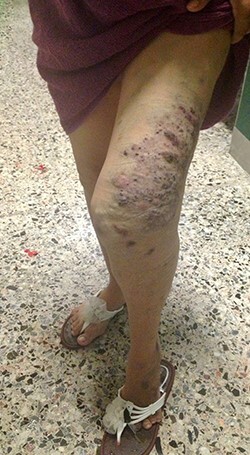A 24-year-old woman with history of Klippel-Trenaunay syndrome (KTS) in her childhood, gravida 2, Para 1 (G2P1) was referred to our hospital for multidisciplinary approach of her second pregnancy. Her first pregnancy was complicated with obstetric hemorrhage requiring hemotransfusion but delivered a healthy baby girl of 2900 grams. During her third trimester of her second pregnancy, she began with edema and varicose veins on left thigh. At 40 weeks, she developed obstetric pain and inability to ambulate. Physical examination showed prominent hypertrophy and multiple dilated varicose veins in the left limb and port wine nevus (Fig. 1). Pregnancy culminated in a transvaginal delivery of a healthy male of 2940 grams. She had 400 mL bleeding during the obstetric event requiring vaginal packing gauze due to superficial mucosal bleeding. Her clinical course was uneventful. Unfortunately, venous doppler ultrasonography was not available to us at the time, and therefore pharmacological thromboprophylaxis was used empirically, after weighing the risk of increased bleeding and the risk of VTE. Nadroparin (3800 IU anti Xa) were started 12 hours post-partum and continued 10 days postdischarge. Subsequent outpatient follow-up showed improvement of her left low er extremity edema, and no new symptomatology was reported.
Figure 1 .

Prominent hypertrophy, dilated varicose veins and port wine nevus in the left limb.
KTS is a rare congenital disorder characterized by a triad of cutaneous hemangioma (port-wine stain), varicose veins and bone or soft tissue hypertrophy affecting one or more limbs. KTS was first described in 1900 [1]. Less than 100 cases of KTS and pregnancy have been reported worldwide [2]. Morbidity from KTS is related to the vascular abnormalities such as venous insufficiency, cellulitis, ulcers or thrombophlebitis. During pregnancy and puerperium, there is an increased risk for venous thromboembolism (VTE) [2], thromboprophylaxis may prevent this dreadful complication. On the other hand, excessive bleeding in the intrapartum period may occur as well. There are no prospective studies evaluating thromboprophylaxis strategies during pregnancy in KTS; however, risk assessment and thromboprophylaxis in a multidisciplinary team-approach fashion is recommended to prevent VTE [3]. The use of pharmacological thromboprophylaxis strategies in such complex cases need further investigations, and both risks of having a significant bleeding versus thromboembolic events must be taken carefully into consideration.
ETHICAL APPROVAL
This case is exempt from IRB approval at our institution.
CONSENT
Written informed consent was obtained from the patient and is available for review upon request.
GUARANTOR
Mateo Porres-Aguilar, MD, FACP, CACP.
ACKNOWLEDGEMENTS
None.
CONFLICT OF INTEREST STATEMENT
The authors declare no conflict of interest associated with this manuscript.
FUNDING
The authors received no financial support for the research, authorship or publication of this article.
REFERENCES
- 1. Lindenauer SM. The Klippel-Trenaunay syndrome: varicosity, hypertrophy and hemangioma with no arteriovenous fistula. Ann Surg 1965;162:303–14. [DOI] [PMC free article] [PubMed] [Google Scholar]
- 2. Horbach SE, Lokhorst MM, Oduber CE et al. Complications of pregnancy and labour in women with Klippel–Trenaunay syndrome: a nationwide cross-sectional study. BJOG 2017;124:1780–8. [DOI] [PubMed] [Google Scholar]
- 3. Xiao L, Peng B, Qu H, Dai X, Xu J. Successful management of Klippel-Trenaunay syndrome in a pregnant Asian woman: A case report. Medicine (Baltimore) 2020;99:e19932. 10.1097/MD.000000000001993. [DOI] [PMC free article] [PubMed] [Google Scholar]


